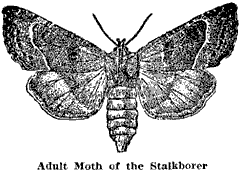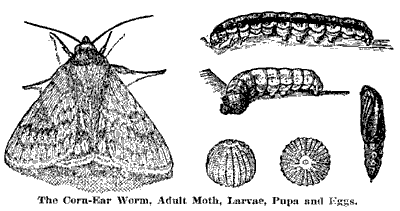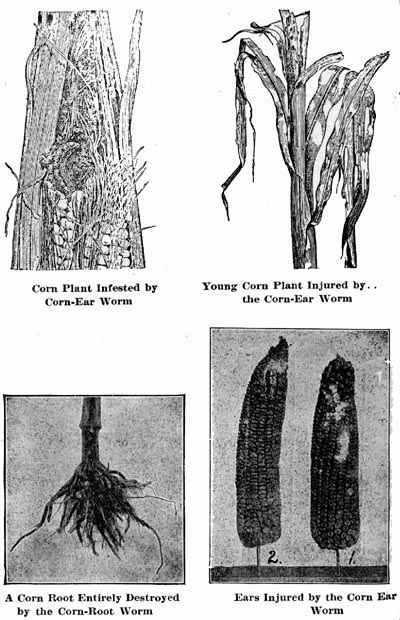
NEGenWeb
Project
Resource Center
Schools
|
244 |
|
feeds on the young roots. These insects are often found in our lawn grasses but not in sufficient numbers to do great damage. After the ground is broken up and planted to corn, we find them attacking the hills of corn in great numbers. They may not only destroy the roots of the young plants, but often eat the grain itself before it has germinated.
They remain in this worm or larva stage for two years. They then pupate or pass into a dormant stage. This generally occurs late in the summer -- July or August. After three or four weeks a long, brownish beetle, known as the click-beetle, comes forth. This beetle either buries itself in the ground or hides under rubbish, or in other sheltered places.
The wireworms do not confine their ravages to corn alone, but injure almost every crop on the farm.
After the worm has once attacked a plant no poison can be applied that will kill the worm and yet not injure the plant. As the larva lives two years, rotation of crops does not entirely eradicate this pest, which often does its worst damage the second year after plowing. When the sod is plowed in the fall it is often advisable to sow to winter-wheat. If clover or oats follow the winter-wheat the two years necessary to develop the larva will have passed.
The ground should be fall plowed as this will turn the pupa to the surface where they can be eaten by birds and destroyed by freezing.
When it is necessary to replant the corn, it is advised to straddle the old rows. The worms will stay around the old plants for some time if left; otherwise, they would immediately attack the corn last planted. The first planting can be plowed out later on.

Because of the nature of its injury this pest Is sometimes called the "Heart Worm." The stalk-borer attacks wheat, oats, timothy, potatoes, corn -- in fact, a large number of plants with soft or pithy stems.
The larva is from an inch to an Inch and a quarter in length and of various shades of purplish brown, the color depending on the age
|
|
245 |
of the larva. This nest is easily recognized by five white stripes running the entire length of its back and n white stripe on each side extending back from the fourth segment. The mouse-colored, night-flying moth of the stalk-borer lays the eggs that produce the larvae. These eggs are laid in the fall in the grass and either hatch the same fail or next spring. The larvae live on weeds and grasses when first hatched, but when more mature attack cultivated crops. Plants injured by the stalk-borer usually turn white at the top, although the remainder of the plant may remain its usual color. This light color of the fop is due to the larvae boring into the stem. Corn is usually attacked when it is less than two feet high. The stalk-borer enters through a small hole made in the stem and burrows upward from this entrance. After the larva has once entered the stem, no remedy can be applied that will eradicate the pest without injury to the plant. However, one can do much toward its eradication by destroying the grass lands in which the larvae first appear. When the heads of timothy and other grasses begin to turn white, due to the presence of the stalk-borer, it should be made into hay and removed at once. It is very seldom that an entire field is destroyed, as the ravages of the stalk-borer are usually confined to the borders.
The corn-root aphis, also known as the corn-root louse, is a pest which has been rapidly increasing the last few years. Plants affected by the corn-root aphis will appear yellow and warped. No other signs may be visible, as the aphis works on the roots, where it sucks the liquid nourishment from the plant.
The corn-root aphis is a soft bluish green insect. It is so sluggish and helpless that it is unable to make its own way about. Therefore it is carried from place to place by the common red field ant. This ant does not injure the corn directly, but it takes care of the eggs of the aphis which are laid in the fall. Very little injury is done by the aphis when alone, as it moves so very slowly, but when the field ant and root aphis work in conjunction great damage is sometimes done. The first generation of aphis is wingless; the second generation contains both winged and wingless young. Aphis are also known to produce living young which lay the eggs in the late fall for the ants to store away. There are about twelve generations in one season. One female will give birth to ten or fifteen living young.
Since the corn-root aphis is found in greater quantities on ground which has been in corn several years a short rotation period in corn is advisable. This is especialy (sic) effective during quite dry years. Deep
|
246 |
|
plowing, either spring or fall, together with deep disking is one of the best known preventives. This method of cultivation destroys many of the ant burrows which contains the eggs of the aphis. It will also rid the field of weeds upon which the young root lice feed until the corn begins to grow.
The northern corn-root worm is about as large around as a common needle and varies in length from one-half to three-fifths of an inch. It is white throughout with the exception of its head, a spot on the last segment, and the top of the first segment, which are of light brown color.
The beetle lays the eggs that produce the larvae in the cornfield about one inch beneath the surface of the ground, where they remain throughout the winter. In June the larvae collie forth and immediately attack the roots of the young corn plants.
The corn-root worm does its greatest damage during the months of June, July and August. When the larva has reached its maturity it buries itself in the ground and pupates. From these pupas come little pale-green beetles, about one-fourth of an inch long, which are the adult form of the corn-root worm. These beetles feed on the silks of the ears, but do very little damage. The female beetles deposit their eggs in the ground, in cornfields, during September and October.
The first indication that a field Is infested with corn-root worms is the stunted, dwarfed appearance of the corn. This is due to the fact that some of the roots have been cut, dimishing (sic) the amount of nourishment. Ground planted to corn for several years is sometimes so badly infested that the stalks will bear nothing but nubbins. When wind strikes a field in which corn-root worms have been working, the whole plant falls, often exposing the injured roots. This uprooting of the corn is often incorrectly attributed to worn-out soil. Often after a heavy rain the short, lacerated roots will give way and the stalks lodge.
These pests are easily destroyed by a rotation of crops, as they eat nothing but corn roots. When the corn roots are removed they starve to death. It is advisable not to keep the same piece of ground In corn more than two years in succession but change with small grains, clover and alfalfa.
The corn earworm varies in color from light green to dark brown and has stripes running lengthwise of its body, which is nearly bare. Its head is yellow and its legs are almost black. It feeds on over seventy different plants and is known as the cornworm, cotton ballworm, tomato worm, etc.
The corn earworm passes the winter in the pupa stage three or four inches below the surface of the ground. The moth emerges from
|
|
247 |

the pupa during the latter part of May and the first part of June. One female moth can produce about two thousand eggs, but they probably average in the neighborhood of five hundred. These eggs are usually laid in the curled leaf of the young plant and soon hatch. The caterpillars are full grown in three weeks. There are three generations in one year. The leaves of the young corn plant are eaten by the first generation, the larva of the second generation destroy the silks and tassels, the larva of the third generation attack the hardening ears.
No remedy is known that will entirely destroy these pests. However, the following suggestions may prove helpful: Plow late in the fall or early in the winter. This will turn many of the pupa to the surface. Give clean cultivation and keep down weeds along fence lines. Planting corn early has doubtless proved the most successful.
These are some of the very few corn destroying insects that do their greatest damage in the adult stage. Corn on sod land is most commonly injured.
The corn bill-bugs are rather large, black or dark brown in color, and have a strong snout or beak, at the lower end of which are strong, sharp jaws. The footless larva of the bill-bug is white, with a hard, dark brown head. It feeds on the roots of timothy and other grasses. The larva pupates in the fall, and the winter is passed in the adult stage. The bill-bug attacks the stem and leaves of the corn plant. Working with its head down it eats long, irregular holes in the stem and tissues of the young plant which is very noticeable as the plant develops. The damage done each year by these pests varies greatly.
Late planted corn is rarely greatly injured by the bill-bug. This is a very common practice among experienced farmers. However, there is one species found in low, swampy places that attacks the corn as late as June. Fall plowing is injurious to the development of all known species of bill-bugs.
|
248 |
|

 |
 |
 |
 |
|
© 2003 for the NEGenWeb Project by Ted & Carole Miller |
|||